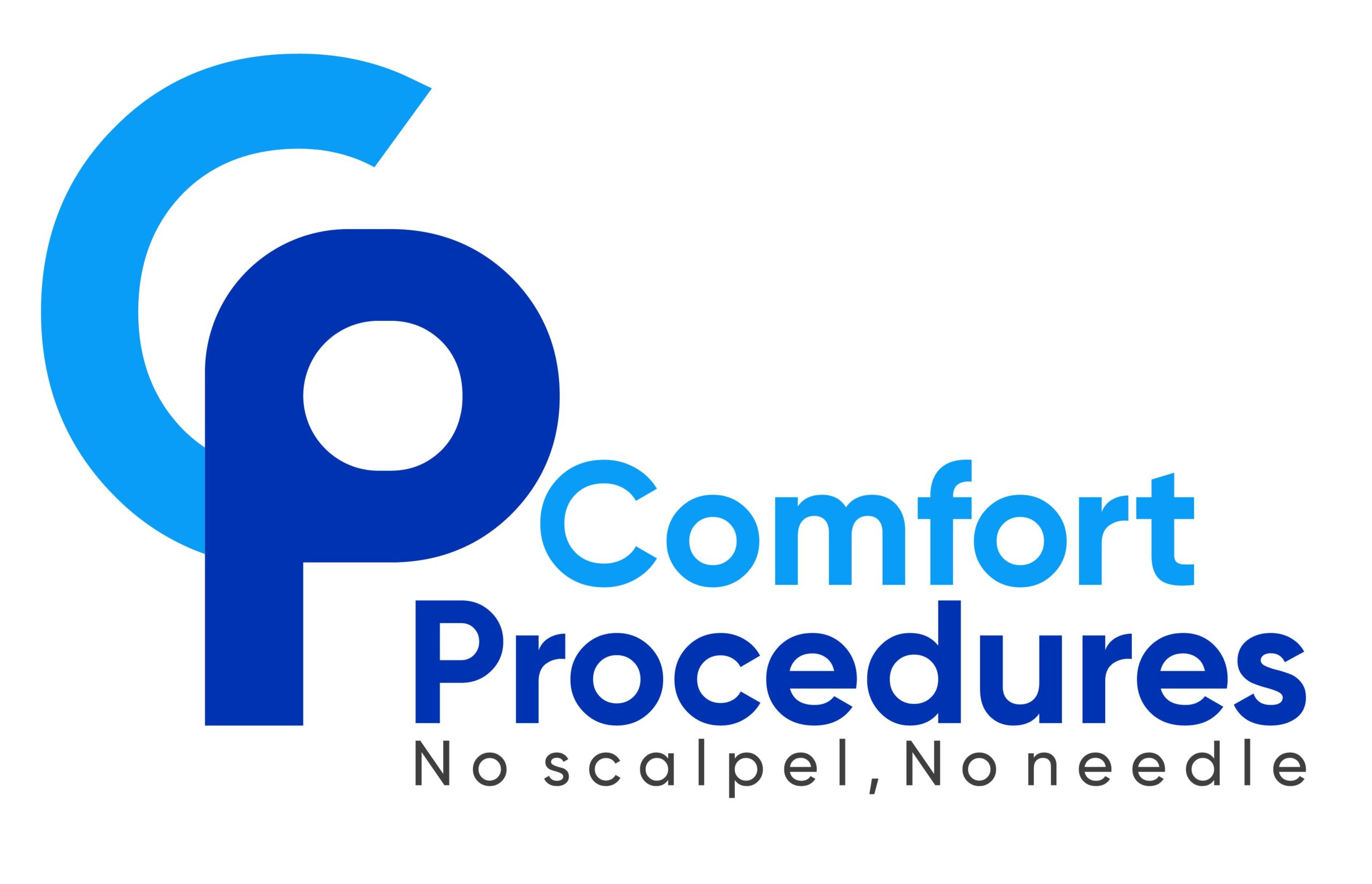No Scalpel, No Needle Vasectomy At Comfort Procedures
The No-Scalpel vasectomy offers a nearly painless alternative to conventional vasectomy surgery. A conventional vasectomy involves making a 1 to 3 inch incision on both sides of the scrotum with a scalpel. No-Scalpel vasectomy involves only a single small opening about the length of a grain of rice, using a special instrument that is not a scalpel. Studies show that no-scalpel vasectomies have a lower complication rate and involve less discomfort than standard vasectomies, especially when coupled with no-needle anesthesia, as we do at Comfort Procedures.
How a Vasectomy Works
A man’s testicles create sperm and sperm are what allow a pregnancy to occur. During ejaculation, the sperm travel through the two vas deferens tubes within the scrotum and combine with semen from the prostate and seminal vesicles.
Contact Us
During a vasectomy surgery, the vas deferens are cut and then sealed. This procedure blocks the tubes so the sperm cannot combine with the semen. After vasectomy, there will not be any noticeable change in the ejaculate because sperm comprise only about 1% of the normal volume.
Your body will continue to produce sperm but any sperm made will be reabsorbed by the body. This reabsorption is a normal process and there are no negative side effects. It is a natural process to prevent a buildup of sperm if there are long periods without ejaculation. Your body naturally breaks down old or unused sperm by dissolving them.
Having a vasectomy means that semen will be ejaculated but without the sperm. The only change will be the inability to cause a pregnancy. Except for the lack of sperm, everything about the sexual experience will be unchanged.
No-Scalpel Vasectomy Procedure
Conventional vasectomies require 2 incisions in each side of the scrotum, to be closed with several stitches. With the no-scalpel method, there is only a single small puncture in the center of the scrotum and no stitches required.
At Comfort Procedures, we specialize in the no-scalpel, no-needle, open-ended vasectomy with facial interposition. Although most vasectomies are performed with the use of a scalpel incision in order to access the tubes, the no-scalpel method is quite different.
With the no-scalpel vasectomy, there is no incision. The procedure is quick and relatively painless.
With the no-scalpel method, the physician locates the vas deferens within the scrotum and places a small clamp to hold them. Instead of making an incision in the scrotum with a scalpel, a special instrument is used to pierce the skin and capture the tubes. The puncture is approximately an eighth of an inch long. By gently stretching the opening, the doctor can locate the vas deferens and carefully pull them one at a time through the opening to be snipped and sealed and released back into the scrotum. The puncture closes immediately after the procedure, without the need for stitches. The only post-surgical dressing necessary is gauze and a bandaid.
Comfort Procedures Center is a leader in the introduction of the no scalpel and no needle vasectomy surgical procedure. Our surgical team has world-class training and support, and we are proud to operate at the highest standard of surgical excellence.
Please call us at 469-931-0684 to book an appointment.
Video: Dr. McAuliff Explains the No-Scalpel Procedure
Compare No Scalpel Vasectomy and Traditional Vasectomy
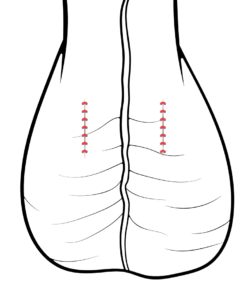
Traditional vasectomy requires 2 incisions and sutures.
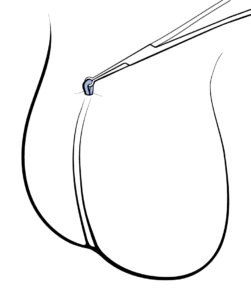
No-scalpel vasectomy has only a small puncture.
The no-scalpel vasectomy offers a nearly painless alternative to conventional vasectomy surgery. Studies show that no-scalpel vasectomies have a lower complication rate and involve less discomfort, especially when coupled with no-needle anesthesia, as is the process at Comfort Procedures.
The no-scalpel, no-needle technique minimizes discomfort. Post-surgical discomfort ranges from none, to a minor ache for a day or two, to slightly sore for a week or so. For this method as compared to the conventional method, there is a lower chance of complication such as infection, bleeding, or prolonged pain and there is faster healing. It is the decision of Dr. McAuliff to provide this technique because it is clearly preferable to complete the vasectomy through a small opening needing no stitches rather than making two larger incisions that need sutures and an extended recovery period to heal.
No-Needle Anesthesia
The idea of a vasectomy in itself is an intimidating proposition. No man enjoys the thought of a needle in the scrotum; however, because a vasectomy is a surgical procedure, an anesthetic is necessary to make a surgical procedure tolerable. In the customary vasectomy surgery, the anesthetic is applied using a needle and syringe. At Comfort Procedures, our goal is to avoid pain and discomfort and to put the patient’s mind at ease. Our no-needle technique of applying the anesthetic makes the entire procedure virtually pain free.
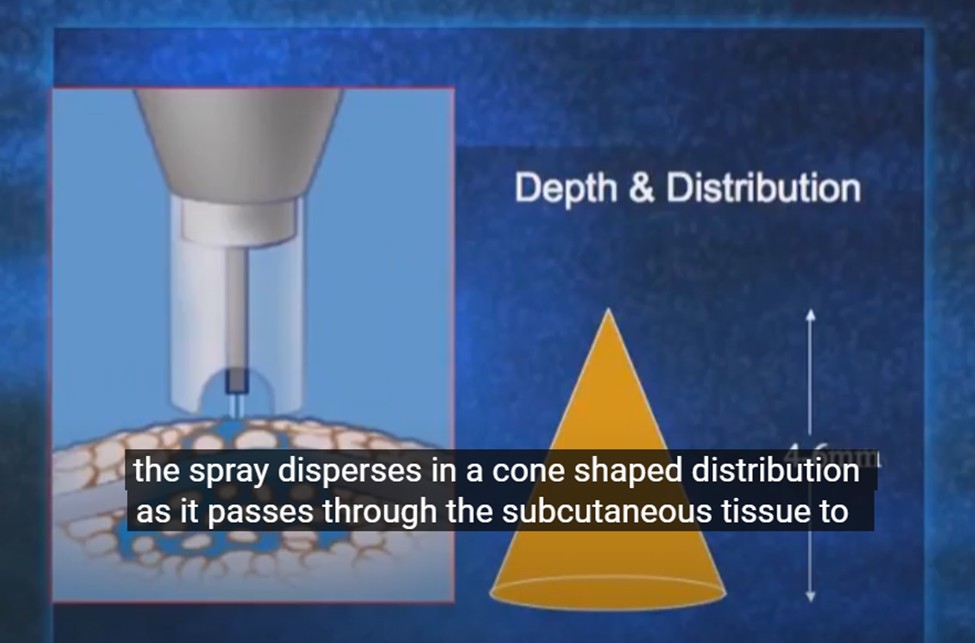 Standard vasectomies require the use of a needle and syringe to inject a numbing agent but that is not the case with the no-needle method we use. Instead of a needle entering the scrotum to deliver the anesthesic, at Comfort Procedures we only use the no-needle approach for the application of a local anesthetic. A pen-size device uses air pressure to force a spray of the anesthetic into the tissues. The device is similar to a high-tech squirt gun. At no time does a needle get close to the scrotum because there is no needle. Nothing except the anesthetic solution penetrates the patient’s skin.
Standard vasectomies require the use of a needle and syringe to inject a numbing agent but that is not the case with the no-needle method we use. Instead of a needle entering the scrotum to deliver the anesthesic, at Comfort Procedures we only use the no-needle approach for the application of a local anesthetic. A pen-size device uses air pressure to force a spray of the anesthetic into the tissues. The device is similar to a high-tech squirt gun. At no time does a needle get close to the scrotum because there is no needle. Nothing except the anesthetic solution penetrates the patient’s skin.
Our method of using a spray device to deliver the anesthetic is less painful than shots and more effective at numbing the area than shots plus psychologically you know you are not getting stabbed with a needle. Our method at Comfort Procedures has those 3 advantages over the conventional method and no disadvantages.
The process of applying the anesthetic is simple. The anesthetic is in liquid form in the jet applicator. The ejection mechanism of the applicator forces the anesthetic through a small opening under pressure. This produces a very fine stream of the anesthetic fluid that passes through the skin. The spray disperses in a cone-shaped distribution as it passes through the tissue. This spreads the anesthetic quickly and far more effectively than does a needle, which deposits a bolus of the anesthetic which spreads unevenly through the tissue.
When you choose Comfort Procedures for your vasectomy, it is your choice to schedule a single visit or you may book a separate consultation and procedure.
Call Us to Book!
469-931-0684
The Open-Ended Technique
The purpose of any vasectomy procedure is to divide the vas deferens tubes for permanent blockage of sperm transportation. After the vas are divided, there is an additional step to prevent transfer of sperm through the vas deferens. The purpose of this step is to close the cut end of the vas deferens.
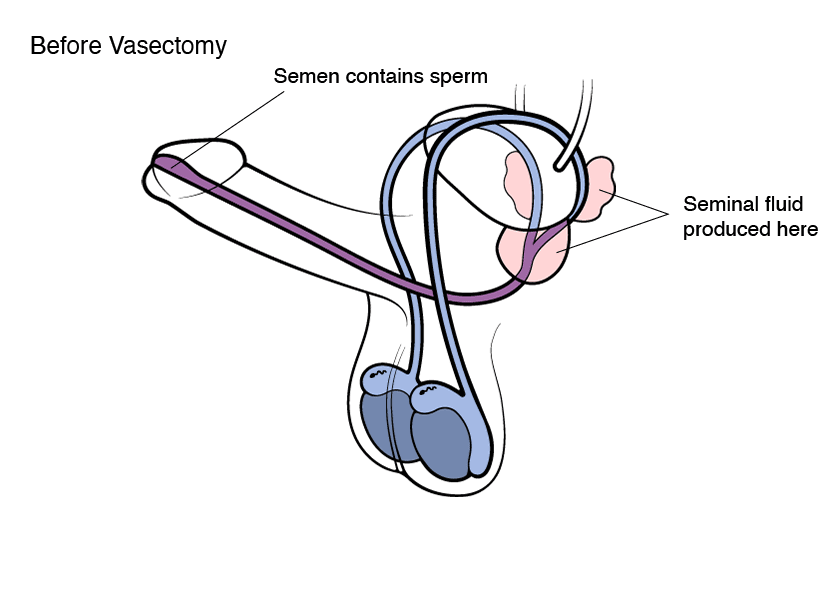
This is the vas deferens before vasectomy.
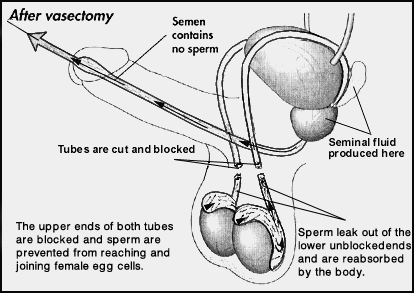
This is the vas deferens after vasectomy.
If the end of the lower portion—where the tubes leave the testicles– is closed with anything (such as cautery, suture, or titanium clip) then this is called a “closed-ended” vasectomy. If the end of the lower portion is left open (not closed by cautery, sutures, or titanium clip), then this is called an “open-ended” vasectomy.
Most vasectomy providers use the closed-end technique, meaning they close both the lower and the upper ends.
When the closed-end technique is used, men frequently experience a sudden pressure build-up in the testicles upon ejaculation. This is because the testicles continue to produce sperm after vasectomy and the closed lower end keeps the sperm build-up during ejaculation from being released. When both ends of the divided vas are closed, upon ejaculation the sperm build-up creates pressure and the closed lower end does not allow for the release of that pressure.
The way to avoid this pressure build-up is to leave the “lower” portion of the divided vas open-ended, not closed. It has been found that this method allows the pressure of the sperm build-up to be released. Leaving the lower end open allows the sperm to leak out, meaning less discomfort. Even though the lower end is left open, the effectiveness of the vasectomy remains.
Even though sperm will continue to be produced, because the tubes are cut the sperm are no longer able to travel the entire length of the vas deferens. In addition, the leakage does not present a pregnancy risk because the other end of the tube has been sealed and the sperm are simply reabsorbed into the body in a natural process.
At Comfort Procedures Center, we use the open-ended technique, closing only the upper divided end but not the lower divided end. He leaves the lower portion of the divided tube open so the sperm can be released without the pressure of being ejected into a closed tube, thus avoiding discomfort. In addition, open-ended vasectomy is associated with less swelling and inflammation and men often report less pain after surgery.
In the past, vasectomy providers were concerned that leaving the lower end open would allow the possibility for ‘reconnection’ of the two divided ends and the likelihood of vasectomy failure. This concern about open ended vasectomy has not proven to be true.
Although it is thought that vasectomy reversal surgery may be more successful after an open-ended vasectomy procedure, a man should not count on that and he should consider a vasectomy to be a permanent contraceptive procedure. Dr. McAuliff recommends that you not have the vasectomy procedure done if you think you may want to father children in the future.
A vasectomy provides nearly 100 percent effective male birth control by cutting the supply of sperm to semen. Find out more about this procedure today. Call us today. 469-931-0684.
Facial Interposition to Complete the Vasectomy
As a final step to ensure the success of the vasectomy, the upper end of the divided tube is cauterized (sealed with high heat) and then is enclosed by a procedure called fascial interposition. The vas tubes are naturally enclosed in a thin sheath. As an additional step of protection, Dr. McAuliff will pull this sheath up over the cauterized end of the upper tube to enclose it with one dissolvable suture.
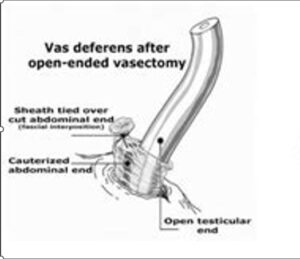 Some methods of fascial interposition use titanium metal clips to close the end of the tube. At Comfort Procedures, we use only dissolvable thread, leaving nothing behind in the scrotum. You’ll never see or feel the stitch because it is internal and it dissolves.
Some methods of fascial interposition use titanium metal clips to close the end of the tube. At Comfort Procedures, we use only dissolvable thread, leaving nothing behind in the scrotum. You’ll never see or feel the stitch because it is internal and it dissolves.
When the vas tubes are cut, cauterized, and sheathed, they are carefully released into the scrotal sac. The small opening is covered with gauze and a band-aid and the patient walks comfortably out of the office. Within a few days, the small opening becomes invisible. Because there are no incisions and no stitches, the no-scalpel technique means very little bleeding and no scarring.
Call Us to Book!
469-931-0684
Possible Risks and Complications with a Vasectomy Procedure
Vasectomy does not affect your sexual function or testosterone levels. In an interview of over 90,000 patients and evidences, it was found that the risks of vasectomy are very small; even smaller than previously thought.
No-Scalpel vasectomies have no life-threatening complications to worry about. There may be minor, short-lived complications that resolve with ice, rest, anti-inflammatory medicine, and time.
After vasectomy at Comfort Procedures, post-surgical recovery is reported to be excellent; however, any of the following reactions might be possible:
• A mild aching sensation in the scrotum for a few hours to a few days after the procedure.
• Mild bleeding into the scrotum may cause mild swelling and tenderness for a few days. (1/400)
• Infection presenting as redness and tenderness at the puncture site which may require a prescription antibiotic. (1/500)
• Scrotal hematoma is a major bleed into the scrotum resulting in as much as grapefruit-sized swelling and a tender scrotum which may take months to heal. (1/1000) The likelihood of a major bleed is reduced if NSAIDs such as aspirin or ibuprofen or prescription anti-coagulants are avoided for 10 days prior to the surgery and if instructions regarding post-surgery activity are followed.
• Post-Vasectomy Pain Syndrome is a rare complication causing a persisting dull ache in the testicle which usually resolves on its own but in rare cases may need a surgical procedure. (1/1000)
What to Expect After Surgery
After your vasectomy at Comfort Procedures, you should go home and rest for the remainder of the day and evening. Minimize any kind of activity.
For the first two days after your vasectomy procedure, please plan on being a couch potato. The very best thing for your speedy return to your regular routine is to rest in order to maximize the speed of healing.
For the entire first week after your procedure, you should avoid lifting over 10 pounds, and any exertion, exercise, extensive walking, climbing, jogging, swimming, or sports. Sexual function may be resumed at 5 days.
You can return to work two days after your procedure. If your job includes lifting anything over 10 pounds or climbing ladders or stairs, it would be best to wait a week before you return to work. Guys who push it and try to return to work too soon are often disappointed by a resultant slower recovery with prolonged pain and higher risk of hematoma. (Hematoma is a grapefruit-sized scrotum, taking 2 to 3 months to heal.)
Because you are not sterile right after your vasectomy, a birth control method is a temporary necessity for 3 months post procedure until a semen analysis at 3 months confirms that no sperm are present. We will provide the information to do the test.
Once the sperm tubes are cut, cauterized, and then separated by the fascial sheath barrier, the chance of sperm being able to slip through the blockage in the sperm tubes is extremely small, but failure is possible. It is for this reason that testing a semen sample is essential. After a minimum of three months, you should get your semen tested for sperm content The staff at Comfort Procedures will provide you with information in your post-op take-home materials.
When you choose Comfort Procedures for your vasectomy, it is your choice to schedule a single visit or you may book a separate consultation and procedure.
Call Us to Book!
469-931-0684
